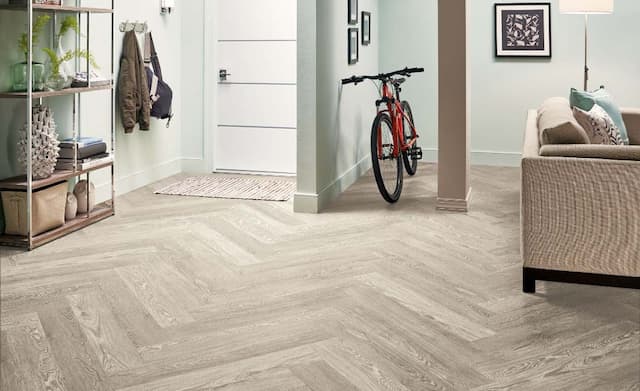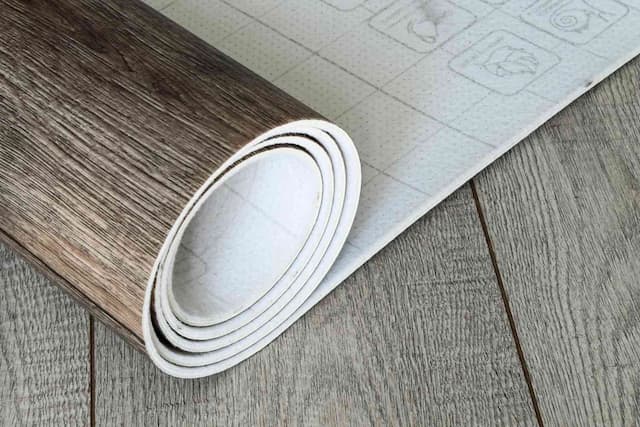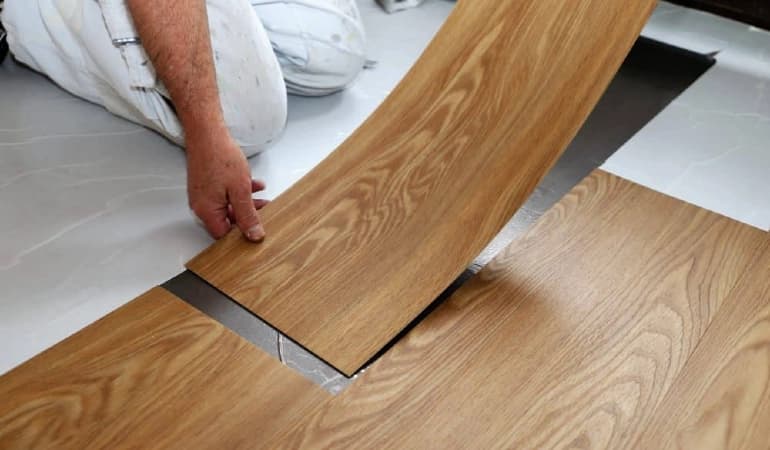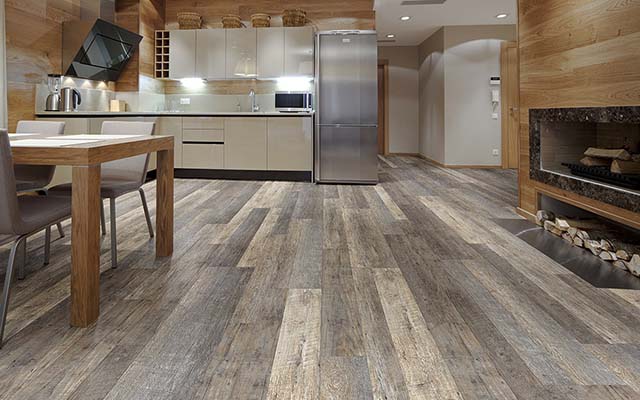You may be asking yourself, “What is vinyl flooring?” – if so, you’re in luck. Discover more about vinyl flooring information such as pros, and cons, types, and construction by reading our guide.
Vinyl flooring is a synthetic flooring material that is durable, affordable and easy to install. Linoleum and laminate flooring are among the other flooring types that vinyl is frequently confused with. Due to their adaptability, durability in damp environments, and resemblance to natural wood and stone, luxury vinyl tile and planks are becoming more and more popular.
Vinyl flooring is a great option for every room in your house because it is long-lasting, inexpensive, water-resistant, and low maintenance. Please read on.
Pros and Cons of Vinyl Flooring
Besides the occasional sweeping and mopping, vinyl requires little maintenance. Below are the pros and cons of Vinyl Flooring.
Vinyl Flooring Pros
For many reasons, people adore vinyl flooring. It is a flooring option that is reasonably priced, strong, and water resistant. It is also offered in a wide range of appealing textures, hues, and fashions that can be matched to almost any room. Vinyl flooring is available in sheets, tiles, and planks for simple DIY installation. Since it won’t stain and handles humidity well, it’s also a great flooring option for bathrooms or laundry rooms.
Vinyl Flooring Cons
Yes, vinyl flooring has some shortcomings. Vinyl flooring may release VOCs after installation and is made with toxic chemicals. If something dents or scratches the floor, it’s also challenging to fix. If a homeowner intends to sell the house, they shouldn’t anticipate getting anything back from their investment in vinyl flooring. Lastly, vinyl flooring may look real thanks to modern technology, but it’s very hard to achieve that “real” feel of hardwood or slate with vinyl flooring that emulates those types of finishes.
The Different Types of Vinyl
Both luxury vinyl tiles (LVT) and vinyl roll flooring, also known as vinyl sheet flooring, are referred to as vinyl flooring.
Luxury Vinyl Tile (LVT)

LVT is a type of vinyl flooring that is designed to imitate natural flooring options such as hardwood and ceramic tile. Vinyl floors can now look and feel almost exactly like the products they’re imitating because of technological advancements and improved design capabilities. LVT comes in a large variety of timeless and trendy designs, in either tile or plank formats to imitate the look of tiles or wooden planks. It also comes in either rigid or flexible tiles and planks. When remodeling a home or a room, LVT’s modular design makes it simple and quick to install. Indeed, closing off one or more rooms won’t have to disrupt daily activities for very long with LVT. With LVT, remodeling can be done while the furniture is still in the space.
Vinyl Roll

Vinyl roll is fibreglass-cushion-backed flooring that comes in large, continuous, flexible sheets, and is available in an almost limitless number of styles, from timeless and realistic to more playful designs. For homeowners, vinyl rolls are also among the most cost-effective flooring options. Also, Vinyl rolls are 100% phthalate-free and have low VOC emissions (except for outsourced products), which contribute to healthier indoor environments.
Construction of Vinyl Flooring
Four layers of material are used to make vinyl flooring.
Wear Layer: This layer is what gives vinyl flooring its durability and water resistance. It is made of a clear, protective urethane sealant. The wear layer’s thickness, measured in mil (thousandths of an inch), determines how long-lasting vinyl flooring will be.
- 0–12 mil: average traffic, good for typical home activity
- 12–20 mil: higher traffic, good for homes with active pets or children
- Over 20 mil: heavy traffic, good for busy commercial areas
Print Layer: This layer is what gives vinyl flooring its appealing appearance. The print layer is a thin film that shows through the clear wear layer and is embellished with the desired flooring pattern.
Core: Depending on the type of core used, vinyl flooring can either be flexible or rigid. Vinyl flooring with a rigid core typically comes in the form of hardy planks or tiles with limited flexibility. Stone plastic composite (SPC) and wood plastic composite (WPC) are both acceptable materials for these ultra-watertight cores, though SPC is typically harder, denser, more compact, and more durable of the two.
Underlayment: This bottom layer, which is composed of fiber, felt, rubber, or foam, adds cushioning, insulation, sound absorption, and durability to vinyl flooring. Underlayment can offer vinyl flooring’s underside with a protective moisture barrier when put over a subfloor that is susceptible to moisture. Check the specifications provided by the flooring manufacturer to be certain before making a purchase. Underlayment can be delivered pre-attached to vinyl flooring or as a separate component.
How Durable is Vinyl Flooring?
Vinyl flooring is generally considered to be a highly durable material. The longevity of your floor is, however, influenced by a number of significant factors. For instance, the durability and life expectancy of your vinyl flooring will be influenced by the type of material used, how it was made, and how well it was installed.
All Tarkett vinyl floors, both our LVT and vinyl roll ranges, are treated with a special PUR surface treatment, which provides extreme protection and makes them even more durable and resistant to scratches or stains. Additionally, they have a transparent wear layer that adds to their durability. Our Rigid LVT also has an enhanced rigid core construction, providing extra resistance and excellent dimensional stability. As a result, there won’t be any rippling, swelling, or changing in size over time of the floor. Despite changes in temperature or moisture, the product will maintain its size and shape. Rigid LVT won’t change in appearance when exposed to heat or cold. In fact, because of how tough its top coat is, it serves as a barrier against various types of harm. It’s also a fantastic option for anyone looking for a high-quality floor that requires little upkeep and for areas with high traffic.

Is Vinyl Waterproof?
Yes, all vinyl flooring products are waterproof because they’re composed primarily of PVC, but the caliber of the installation may have an impact on how water-resistant they are. LVT, for example, has several seams because it is made of planks or tiles that fit next to one another. The planks and tiles themselves are waterproof, but if you install them improperly, water or moisture may seep through the seams. In contrast, vinyl roll comes in sheets, and when it is installed, there are typically very few, if any, seams.
Both LVT and vinyl roll can be installed in moist areas like the kitchen and bathroom by carefully following the manufacturer’s instructions.
How Long Do Vinyl Floors Last?
Depending on the quality, installation, and maintenance methods used, vinyl floors can last anywhere from 5 to 25 years.
Why is Vinyl Flooring Slip-resistant?
Vinyl is a type of flooring material that is intended to be nonslip. Additionally, most vinyl floors, particularly those in the safety ranges, offer a high level of slip resistance in consistently wet areas where contaminants may be present. For instance, Polyflor’s Polysafe ranges passed the Pendulum, Abrasion, and ramp tests with high levels of slip resistance, ensuring superior comfort while maintaining high performance and safety.
Is It Easy to Install Vinyl Flooring?
With the aid of experts, many vinyl floorcoverings can be installed more quickly. Expona Simplay PUR, for instance, is a line of loose lay vinyl tiles and planks from Polyflor that was created for heavy commercial interiors where aesthetics, functionality, and quick project turnaround are required.
Difference Between Laminate and Vinyl Flooring
In contrast to vinyl flooring, which is made of artificial materials, laminate flooring contains some wood. This is the main cause of laminate flooring’s susceptibility to moisture and humidity. Laminate flooring has a core made of wood fiberboard that is covered in a clear protective layer with an image of wood grain. To create a more rigid and realistic flooring material, all of these layers are laminated together. In order to replicate the appearance and feel of hardwood floors, laminate flooring is typically sold in planks that snap together.
FAQs
Is Vinyl Flooring Easy to Clean and Maintain?
The best option for low-maintenance flooring is likely vinyl flooring or luxury vinyl tile. For example, all the LVT collections from POLYFLOR are resistant to everyday dirt, soil or accidental splashes, which make the cleaning process much easier. To get rid of any loose dust, grit, or dirt, sweep or vacuum the floor. You can simply mop the floor and rinse it with clean water for a deeper clean. In addition, each LVT collection has a polyurethane reinforcement (PUR) layer on top of the floor layers to facilitate easy maintenance.
Why is It Safe to Use Vinyl Flooring in Your Interior?
By producing vinyl planks and tiles for homes and businesses with extremely low VOC emissions thanks to safety regulations and cutting-edge technologies, vinyl manufacturers like POLYFLOR significantly contribute to the creation of positive indoor environments. A safe floor option for your interior, All Polyflor vinyl ranges have undergone numerous independent and rigorous VOC tests and have approval certifications like Eurofins, Agbb, and Finland M1 test.
Where Can You Use Vinyl Flooring?
Healthcare, education, retail, leisure, housing, the workplace, and the public sector are just a few of the commercial and residential settings where vinyl flooring works best.
Conclusion
Vinyl flooring is typically made of 100% synthetic materials, primarily fiberglass and PVC. For high foot traffic and moist areas like kitchens, bathrooms, classrooms, clinics, and many institutional applications, it can withstand heavy use and is one of the best affordable and water-resistant floor options.
If you have any questions, please leave a comment.
For reading, I’m grateful.



